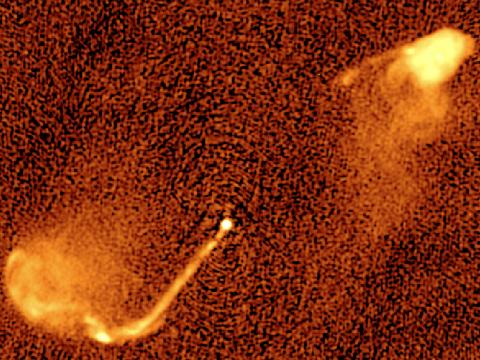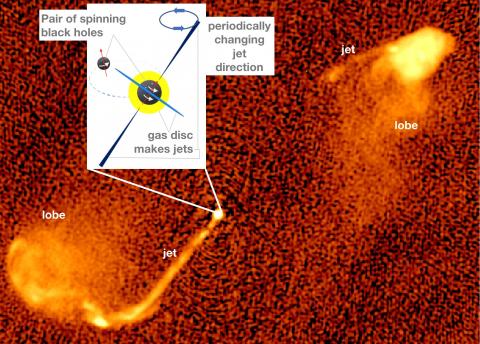New research, published today in the journal Monthly Notices of the Royal Astronomical Society, has found evidence for a large number of double supermassive black holes, likely precursors of gigantic black hole merging events. This confirms the current understanding of cosmological evolution - that galaxies and their associated black holes merge over time, forming bigger and bigger galaxies and black holes.
Astronomers from the University of Hertfordshire, together with an international team of scientists, have looked at radio maps of powerful jet sources and found signs that would usually be present when looking at black holes that are closely orbiting each other.

Before black holes merge they form a binary black hole, where the two black holes orbit around each other. Gravitational wave telescopes have been able to evidence the merging of smaller black holes since 2015, by measuring the strong bursts of gravitational waves that are emitted when binary black holes merge, but current technology cannot be used to demonstrate the presence of supermassive binary black holes.
Supermassive black holes emit powerful jets. When supermassive binary black holes orbit it causes the jet emanating from the nucleus of a galaxy to periodically change its direction. Astronomers from the University of Hertfordshire studied the direction that these jets are emitted in, and variances in these directions; they compared the direction of the jets with the one of the radio lobes (that store all the particles that ever went through the jet channels) to demonstrate that this method can be used to indicate the presence of supermassive binary black holes.
Dr Martin Krause, lead author and senior lecturer in Astronomy at the University of Hertfordshire, said: “We have studied the jets in different conditions for a long time with computer simulations. In this first systematic comparison to high-resolution radio maps of the most powerful radio sources, we were astonished to find signatures that were compatible with jet precession in three quarters of the sources.”
The fact that the most powerful jets are associated with binary black holes could have important consequences for the formation of stars in galaxies; stars form from cold gas, jets heat this gas and thus suppress the formation of stars. A jet that always heads in the same direction only heats a limited amount of gas in its vicinity. However, jets from binary black holes change direction continuously. Therefore, they can heat much more gas, suppressing the formation of stars much more efficiently, and thus contributing towards keeping the number of stars in galaxies within the observed limits.
Media contacts
Ms Rebecca Cussens
Media and PR Officer
University of Hertfordshire
Tel: +44 (0)1707 286 476 (internal 3476)
Dr Robert Massey
Royal Astronomical Society
Tel: +44 (0)20 7292 3979
Mob: +44 (0)7802 877 699
Dr Morgan Hollis
Royal Astronomical Society
Tel: +44 (0)20 7292 3977 x118
Mob: +44 (0)7802 877 700
Science contacts
Dr Martin Krause
University of Hertfordshire
Image and caption

Further information
The new work appears in: “How frequent are close supermassive binary black holes in powerful jet sources?”, M.G.H. Krause, S.S. Shabala, M.J. Hardcastle, et al., Monthly Notices of the Royal Astronomical Society (2018), in press (DOI: 10.1093/mnras/sty2558).
A copy of the paper is available from: https://doi.org/10.1093/mnras/sty2558
Notes for editors
About the University of Hertfordshire:
The University of Hertfordshire is a vibrant, inclusive, campus-based institution with a vision to be internationally renowned as the UK's leading business-facing university. It is innovative and enterprising and challenges individuals and organisations to excel. All courses are underpinned by industry insight and powerful research ensuring our student community of over 24,600 graduates are equipped with the skills and attributes for successful professional lives. The University has excellent progression rates to employment – 96.5% of students are in employment or further study six months after graduating* - and its teaching expertise has recently been awarded the top gold ranking in the Government’s Teaching Excellence Framework (TEF) 2018. It is one of the top 150 universities in the world under 50 years old, according to the new Times Higher Education 150 under 50 rankings 2018. For more information visit: www.herts.ac.uk
The Royal Astronomical Society (RAS, www.ras.ac.uk), founded in 1820, encourages and promotes the study of astronomy, solar-system science, geophysics and closely related branches of science. The RAS organizes scientific meetings, publishes international research and review journals, recognizes outstanding achievements by the award of medals and prizes, maintains an extensive library, supports education through grants and outreach activities and represents UK astronomy nationally and internationally. Its more than 4,000 members (Fellows), a third based overseas, include scientific researchers in universities, observatories and laboratories as well as historians of astronomy and others.
The RAS accepts papers for its journals based on the principle of peer review, in which fellow experts on the editorial boards accept the paper as worth considering. The Society issues press releases based on a similar principle, but the organisations and scientists concerned have overall responsibility for their content.
Twitter: https://twitter.com/royalastrosoc
Facebook: https://facebook.com/royalastrosoc
Instagram: https://www.instagram.com/royalastrosoc/
YouTube: https://www.youtube.com/user/RoyalAstroSoc/feed

